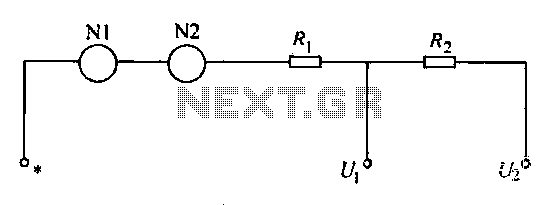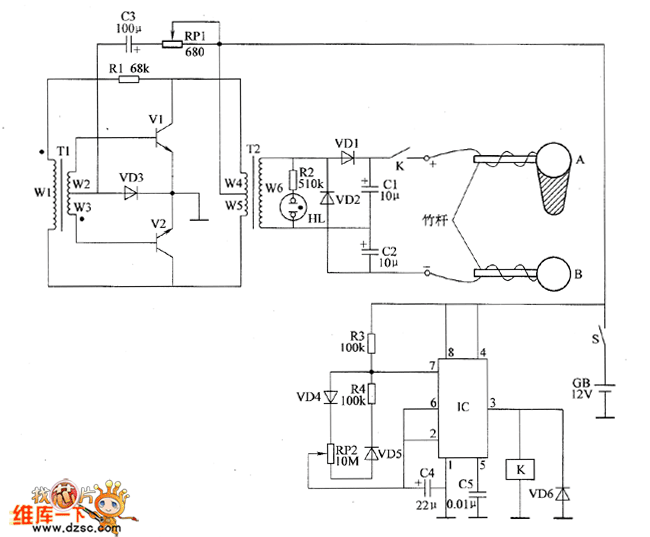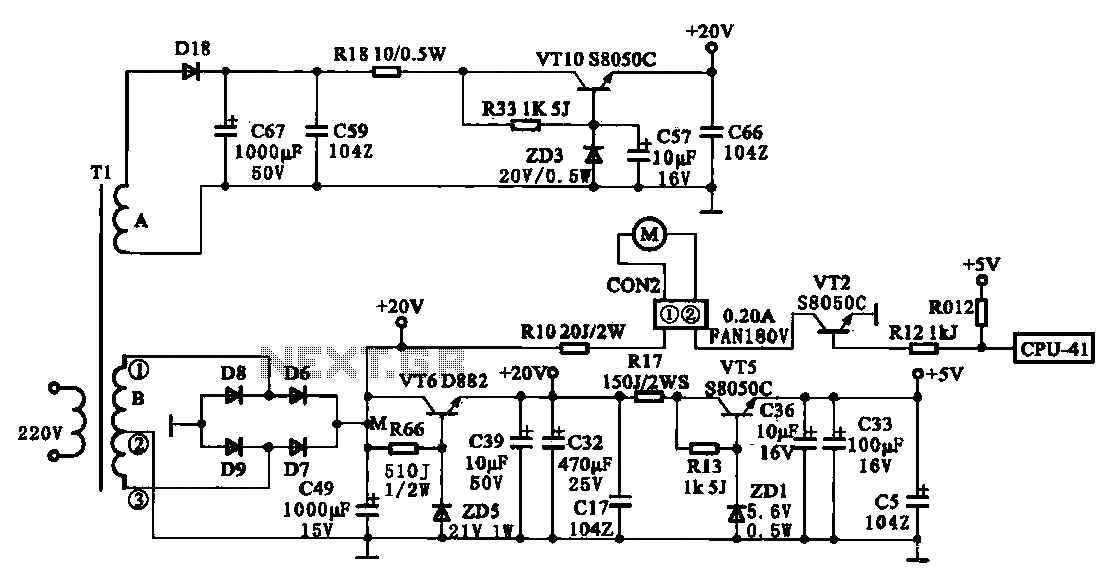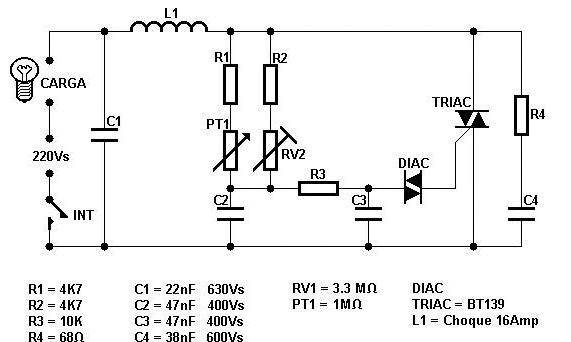
Novel FM receiver circuit diagram

This article discusses the functionality of a super-regenerative FM receiver. The principle behind this receiver utilizes high-gain miniature integrated circuits, resulting in a simple and innovative circuit design. It achieves the performance level of standard FM receivers while addressing the common drawbacks of super-regenerative receivers, such as selectivity and noise. The design maintains high sensitivity, low power consumption, and a low cost, with components totaling less than $5, making it suitable for electronics enthusiasts. The circuit diagram illustrates the super-regenerative FM receiver, FM-AM conversion section, and low-level amplitude modulation detection circuit. The super-regenerative receiver converts FM waves into amplitude-modulated (AM) waves, with an envelope detector used to extract low-frequency signals. The transistor VT1 and its associated components form a typical super-regenerative FM receiver circuit, converting FM wave signals into AM signals and producing audio output through envelope detection. If the audio signal is taken directly from the envelope detector after amplification, it may introduce significant noise and reduce receiver selectivity. To address this, the design includes a high-frequency choke in series with the AM signal for further frequency amplification, enhancing the audio output while mitigating these issues. When operating, VT1 generates an AM modulated signal from the FM input, which is demodulated by the micro IC1 7642 using transformer T1. This integrated circuit features a high-impedance input stage and includes three high-frequency amplification stages, achieving a gain exceeding 70dB. The audio signal output from the detector is coupled to capacitor C9 for low-frequency amplification, with the output directed through the headphone jack for listening to radio broadcasts. High-frequency choke T2 is employed to prevent high-frequency signals from forming loops with the battery and other components, ensuring that audio signals remain unaffected. Capacitor C6 is a small ceramic trimmer capacitor, which requires a movable piece to be soldered for tuning adjustments, minimizing the impact on the tuning circuit's human body sensors. The high-frequency inductor L1 is constructed from 1.0mm enameled wire, wound on a rod with three turns. The high-frequency choke transformer T1 is salvaged from an old AM-IFT miniature device, with the original wire removed and replaced with high-strength 0.07mm enameled wire, creating approximately 50 turns for the primary coil and 150 turns for the secondary coil, which can be adjusted with a magnetic cap and outer shield. The high-frequency choke T2 is made from 0.2mm enameled wire, wound around a ring for about 10 turns. Initial adjustments are made by setting R1 to achieve a collector current of VT1 between 0.3mA to 0.5mA, and adjusting resistance R7 to set VT2's collector current to approximately 2mA. At this stage, headphones can be used to listen for the "trace" sound of electrical noise, and by adjusting C6, FM radio programs can be received. Fine-tuning of L1 and T1 is necessary to maintain optimal sound quality while adjusting the volume.This article describes the use of super-regenerative FM receiver FM receiver principle, due to the use of high gain miniature integrated circuits , it is simple and novel circuit. Reach the level of the general reception of FM receivers, while overcoming the super-regenerative receiver selectivity, noise and other shortcomings, while maintaining a high sensitivity, low power consumption, low cost and simple circuit (element on less than $ 5) and so on. Suitable for the production of electronic enthusiasts. The machine circuit diagram shown in FIG. .png"> Received by the super-regenerative FM, FM-AM conversion section, and low-level amplitude modulation detection circuit.
Super-regenerative receiver FM wave, in fact, will be converted into the FM wave amplitude modulation, while the wave amplitude modulation envelope detector to obtain a low-frequency signal. FIG transistor VTl and peripheral components typical super-regenerative FM receiver circuit, and the FM wave signals into AM signals and envelope detection output audio signal.
If you remove the end of the audio signal directly from R3 envelope detection after amplification, the resulting audio noise is relatively large, but the receiver selectivity deteriorated. Thus, this uses from VT1 emitter by induction to the series circuit of the high-frequency choke AM signal further frequency amplification, detection output audio signals to overcome these shortcomings.
When VT1 work on the high-frequency choke will form an AM modulated signal FM programs. This signal is coupled to a dedicated receiver AM amplitude modulated wave on micro IC1 7642 demodulated by the transformer T1. Piece integrated circuit comprises a high-impedance input stage, the whole process of the three high-frequency amplification and detection output, and gain greater than 70dB.
The audio signal output from the detector is coupled to the capacitor C9 low-frequency amplification transistor VT2, CZ through the headphone jack output to a load (headset) to listen to radio programs. High-frequency choke T2 is to prevent high-frequency signal to the battery and other parts to form a loop and are attenuated, but the audio signal but no impediment.
Capacitor C6 for small ceramic trimmer capacitors that require access to the movable piece in figure A welding end, the objective is to reduce the impact on the human body sensors Tuning tuning circuit. High-frequency inductors L1 using µ1.0mm µ5.0mm enameled wire wound on the rod 3 turns bodiless.
Selection of high-frequency choke transformer T1 removed from the old machine AM-IFT miniature in the week around the system, the original wound on "workers" shaped core wire removed, and then re-enameled high strength µO.07mm around the primary part of the high-frequency choke coil wound about 50, about 150 secondary inductive coil around the part added after adjusting magnetic cap and outer shield can be. Selection of high-frequency choke T2 holes ring, enameled wire with µ0.2mm each well made around 10 laps.
By adjusting the first R1 to VT1 collector current adjusted to 0.3mA-0.5mA, adjust the resistance R7 VT2 collector current of about 2mA. At this point you can use headphones to listen to "trace" the sound of flowing water (electrical noise), by adjusting the capacity of C6 to listen to FM radio programs.
Fine tune L1 and T1 turn away from magnetic cap to keep the volume of the best sound quality.
Super-regenerative receiver FM wave, in fact, will be converted into the FM wave amplitude modulation, while the wave amplitude modulation envelope detector to obtain a low-frequency signal. FIG transistor VTl and peripheral components typical super-regenerative FM receiver circuit, and the FM wave signals into AM signals and envelope detection output audio signal.
If you remove the end of the audio signal directly from R3 envelope detection after amplification, the resulting audio noise is relatively large, but the receiver selectivity deteriorated. Thus, this uses from VT1 emitter by induction to the series circuit of the high-frequency choke AM signal further frequency amplification, detection output audio signals to overcome these shortcomings.
When VT1 work on the high-frequency choke will form an AM modulated signal FM programs. This signal is coupled to a dedicated receiver AM amplitude modulated wave on micro IC1 7642 demodulated by the transformer T1. Piece integrated circuit comprises a high-impedance input stage, the whole process of the three high-frequency amplification and detection output, and gain greater than 70dB.
The audio signal output from the detector is coupled to the capacitor C9 low-frequency amplification transistor VT2, CZ through the headphone jack output to a load (headset) to listen to radio programs. High-frequency choke T2 is to prevent high-frequency signal to the battery and other parts to form a loop and are attenuated, but the audio signal but no impediment.
Capacitor C6 for small ceramic trimmer capacitors that require access to the movable piece in figure A welding end, the objective is to reduce the impact on the human body sensors Tuning tuning circuit. High-frequency inductors L1 using µ1.0mm µ5.0mm enameled wire wound on the rod 3 turns bodiless.
Selection of high-frequency choke transformer T1 removed from the old machine AM-IFT miniature in the week around the system, the original wound on "workers" shaped core wire removed, and then re-enameled high strength µO.07mm around the primary part of the high-frequency choke coil wound about 50, about 150 secondary inductive coil around the part added after adjusting magnetic cap and outer shield can be. Selection of high-frequency choke T2 holes ring, enameled wire with µ0.2mm each well made around 10 laps.
By adjusting the first R1 to VT1 collector current adjusted to 0.3mA-0.5mA, adjust the resistance R7 VT2 collector current of about 2mA. At this point you can use headphones to listen to "trace" the sound of flowing water (electrical noise), by adjusting the capacity of C6 to listen to FM radio programs.
Fine tune L1 and T1 turn away from magnetic cap to keep the volume of the best sound quality.





